Before You Take Your E-Bike to the Road or Trails, Master These Handling Skills

"Hearst Magazines and Yahoo may earn commission or revenue on some items through these links."
E-bikes continue to grow in popularity as a means of commuting to work, getting out on the trails, or just recreationally cruising around town. In fact, the e-bike market is expected to grow to more than 40 billion by 2030, increasing by more than 10 percent annually, according to Precedence Research, a market insights company.
While it’s amazing that e-bikes bring new riders to cycling and allow longtime cyclists to enjoy the ride in a different (speedier) way, e-bikes can be harder to handle than a regular bike, which means they require a certain skill set. So, what should you be thinking about when zipping around town using your e-assist to boost your ride?
To answer that question, we spoke with Alison Dewey, the director of education at the League of American Bicyclists, who’s been tasked with creating a course for new e-bike riders.
“E-bikes have really expanded cycling,” says Dewey. “There are so many people who never thought about traveling by bike, and now they’re finding it’s easy to get to places without getting sweaty, while carrying more stuff. E-bikes are a great addition to the transportation landscape. But education around them is definitely key: the faster the speeds, the higher the risk of a more serious crash.”
Here, she shares some valuable tips for smart e-bike handling skills.
Understand Where You Can Take Your E-Bike
“There is such a broad range of e-bike styles, from the type of bike—cruiser, road, mountain bike, cargo bike—to the style of e-assist that it offers,” says Dewey. That means if you’re buying a new e-bike, make sure you understand what kind of bike you’re buying.
Before you buy, understand what your top speed will be as you ride. Dewey suggests checking local regulations around what you can ride on the road, bike path, and the trail near you, as some spots have regulations around electric bikes. It would be a bummer to buy a great new e-bike capable of hitting 25 mph only to realize you can’t legally ride it on the bike path you use to commute to work!
Get to Know Your Battery
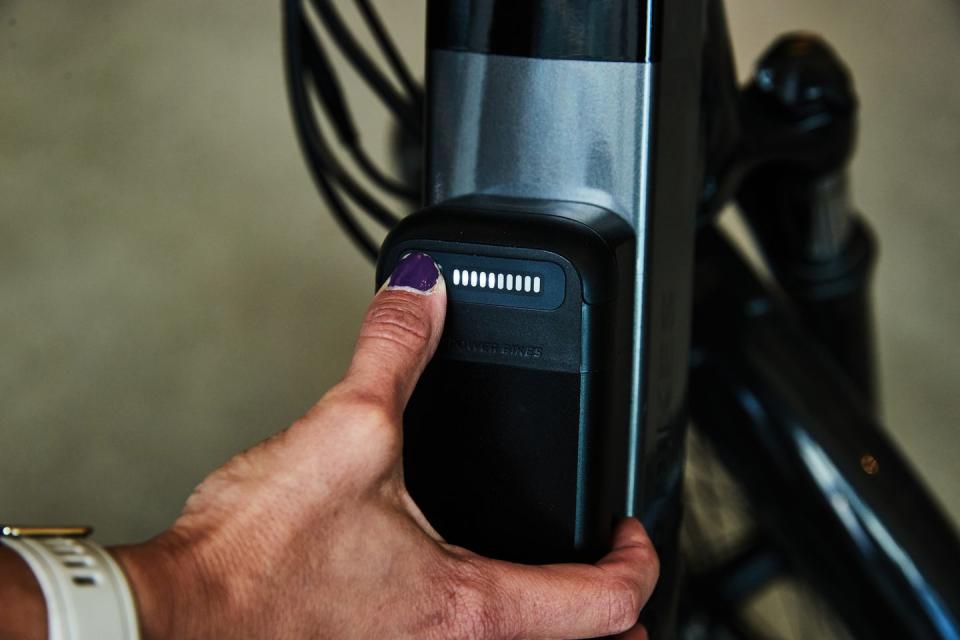
“Be cognizant of your battery life,” says Dewey. “If you’re used to riding a regular bike for a few hours at a time, you may not think about needing enough battery power to get back from a long ride. But you may not have as much range as you think [on an e-bike], especially if you’re using the e-assist a lot. And once it dies, it can be pretty hard pedaling a heavy e-bike that doesn’t have any power.” (If you thought your wireless shifting battery dying was tough… this is a hundred times tougher!)
Practice in an Empty Parking Lot
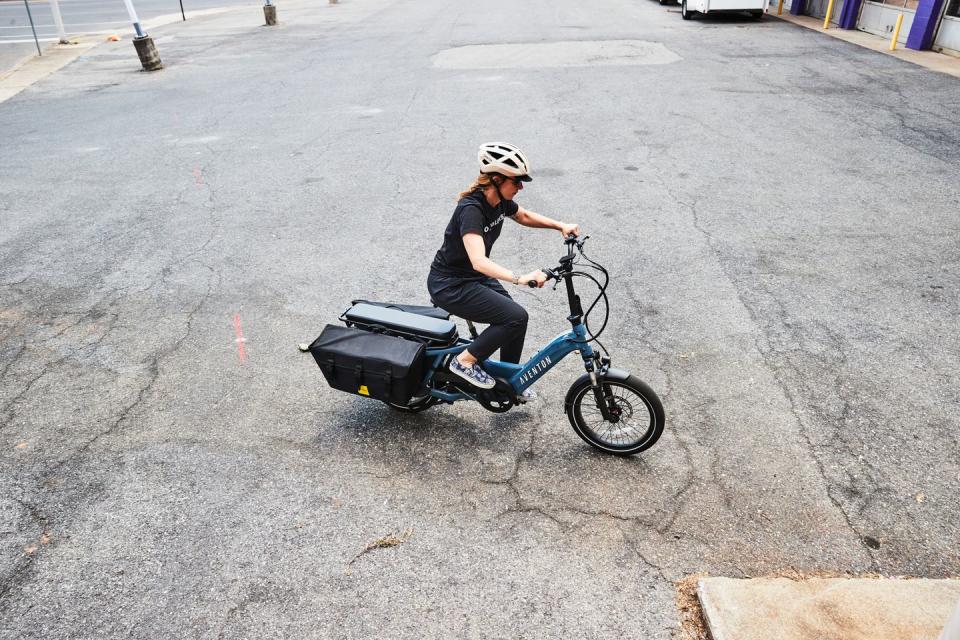
Because e-bikes are typically a lot heavier than your average bike and require a bit of adaptation to get used to the throttle/speed adjustment features, Dewey recommends practicing in a traffic-free space before you hit the road.
Even if you’ve been riding for a long time, you may find getting started feels a bit different, as balance will be tricker due to the bike’s weight. And using the e-assist does take some getting used to, especially if you’ve never ridden a motorcycle, dirt bike, or other two-wheeled, electric vehicle. No, an ebike doesn’t speed up just like a motorcycle, but there will be a slight jolt as you pedal and the e-assist kicks in to power you up.
Some people adjust almost instantly to e-bike handling and it feels perfectly natural, while others will feel awkward at first—don’t panic if it feels a little scary the first time you add a bit of power to your pedaling!
Be Predictable
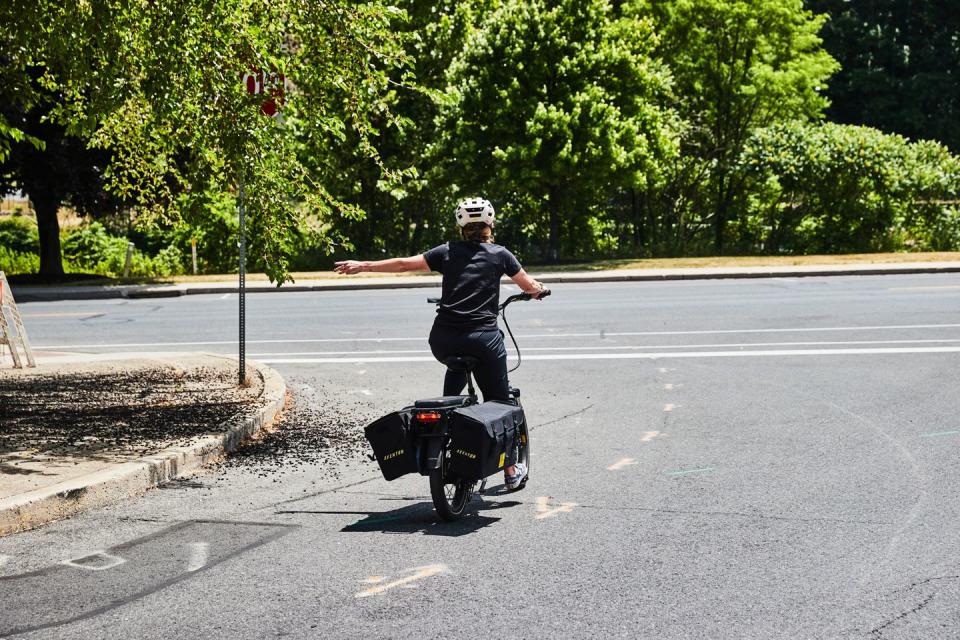
While predictability is a cornerstone of riding any type of bike, e-bikes offer new levels of unpredictability because you can speed up without looking like or feeling like you’re putting in a harder effort. So, if you’re riding with others in a group, or just riding around other cyclists in a bike lane, be hyper-vigilant.
“Predictability is so key when you're riding an e-bike,” says Dewey.“Signal your turns and when you’re slowing or stopping, and get comfortable controlling your bike with one hand so that you can easily signal when needed.”
Practicing these signals—turns, stops, slows—in an empty lot is also smart before you hit busy streets.
Practice Cornering
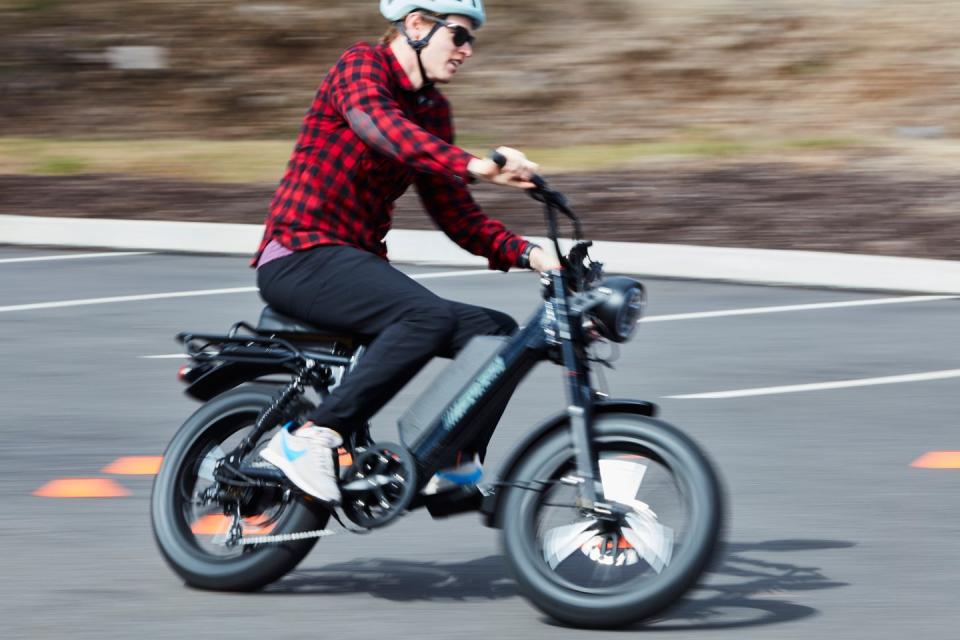
When cornering on a road bike, you’re often given a few standard cues: Outside foot down, look around the corner at where you want to go, lean into the turn, and don’t brake while in the turn. On an e-bike, this is all still important, but Dewey points out that the heavier e-bikes may not be as smooth at cornering as your 15-pound road bike. “With the heavier battery, you do need to think about how you’re leaning, because it can change your balance point,” she says.
If you’re using an e-cargo bike, Dewey says, it’s also important to understand that your turning radius is going to be wider than the tight turns you make on a road bike. This is another good reason to practice in a parking lot, even setting up some cones in order to test exactly how much space it takes for you to make a turn at different speeds.
Whatever you do, Dewey adds: “Do not accidentally hit the throttle on your e-bike when you’re initiating the turn!” A handlebar throttle, which you typically engage by twisting the handle (different than pedal-assist), will be near the brakes. “Be very aware of the difference between your throttle and the brake lever,” she says. Sounds simple, but depending on your bike setup, this may take some getting used to!
Get Good at Braking
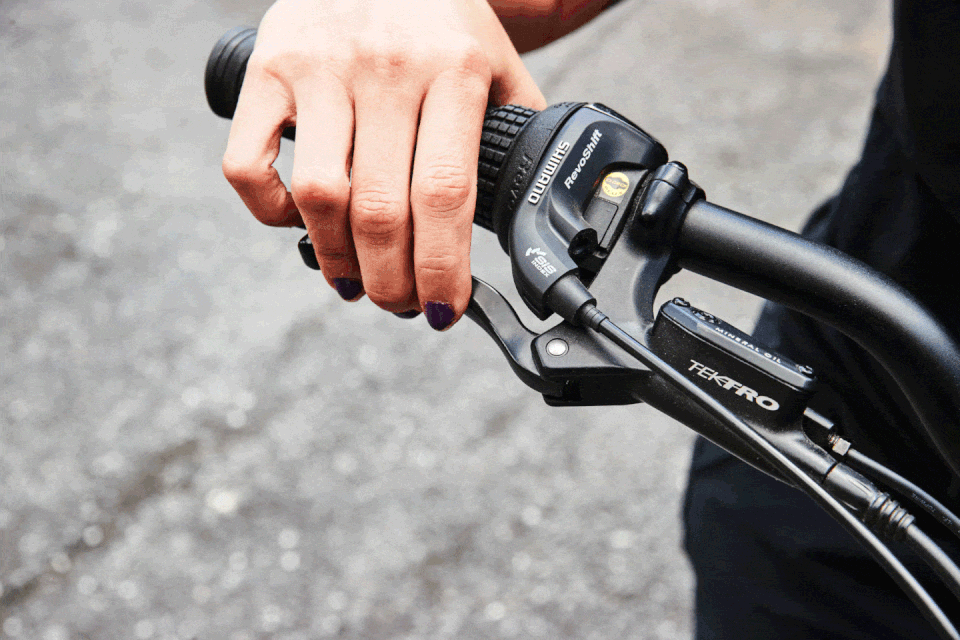
“Your stopping distance might be a little longer on an e-bike, too,” says Dewey. “You may also need more force in order to stop, especially for abrupt stops.” Because of this, spend time in a parking lot without cars around to better understand how to smoothly stop when going at higher speeds.
This is especially true for cyclists who’ve never been able to push high speeds on the bike before—there are many e-bike riders who’ve never gone over 15 mph on standard bikes and may find the higher speeds intimidating. (And as Dewey noted earlier, depending on your bike setup, you may accidentally hit the throttle when you mean to brake—so it’s pretty crucial to learn where your brakes are!)
Do Your Regular Bike Check
E-bikes might feel more like a car or motorcycle, but they do require the same TLC that your regular bike does. In fact, because you’re likely carrying more and going faster, regular maintenance is even more important. “Before you even get on your bike, do your quick bike check,” says Dewey.
That includes:
Is there enough air in your tires?
Are your brakes working?
Is your battery charged?
Are the chain, cassette, and chainrings free of debris?
Are any quick releases closed/are the wheels mounted securely?
For cargo bikes, check for anything (straps, bags) flapping around or hanging loose, and make sure nothing is interfering with the wheels turning or the pedals.
Remember That Drivers Don’t Know You’re on an E-bike
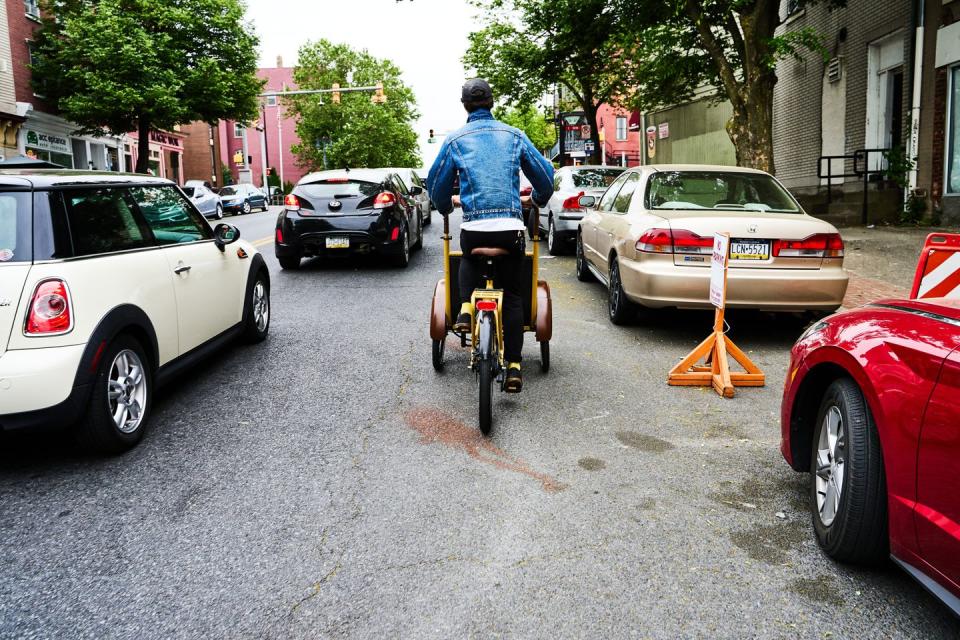
E-bikes can potentially be more unpredictable for drivers: Drivers have a certain expectation of how fast a cyclist can ride. If you’re on the road and hit the e-assist and increase your speed suddenly, it can cause confusion for drivers. To be clear, drivers should be aware of riders around them—but we unfortunately know that isn’t always the case. Dewey says that the best way to know if a driver sees you is to make eye contact with the driver.
“Eye contact is the best form of communication with a driver,” she says. “For cyclists, the most common collision scenarios are the right hook, the left hook, overtaking, and dooring. The left hook is likely the most dangerous for e-bike riders, because it happens when a person on a bike is traveling through an intersection, and a driver is turning left into the pathway of the person on a bike. The driver may underestimate the speed of the person on a bike, or possibly doesn’t see the cyclist due to another car or because they’re not paying attention.”
Just like when riding a regular bike, pay attention to the cars around you. Watch for turn signals and sudden braking in front of you, and stay aware of what’s going on behind you.
Be Aware of Trail Etiquette
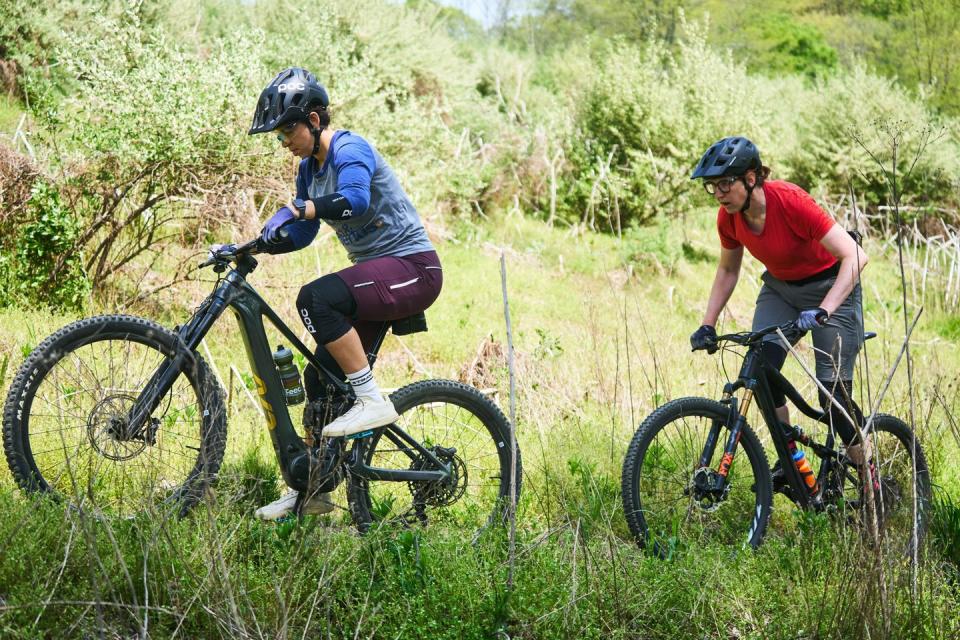
Etiquette for e-bike riders is still in its infancy. For the most part, follow the rules of etiquette for any other type of cycling. Just know that with higher speed capabilities, there are some nuances, especially when on multi-use paths and trails.
“Trails are typically designed for riding at 15 mph or less,” says Dewey. “On an e-bike, you can easily get into the 20s, and if you prefer to travel at those higher speeds, you may want to consider riding on the road. If speed is your priority, go where the faster flow of traffic is—and always ride with traffic, not opposing it. If you stick to the multi-use path, verbal communication between you and anyone you’re overtaking is key—give plenty of warning when you’re passing.”
If you’re riding on mountain bike trails, in addition to being mindful to avoid wet conditions where your tires will tear up trails, make sure that e-bikes are actually allowed in the trail network you’re riding. (Check the trail system website before you head out.) And while you’re out there, ride at a speed that is courteous and not disruptive to others.
Stay Visible
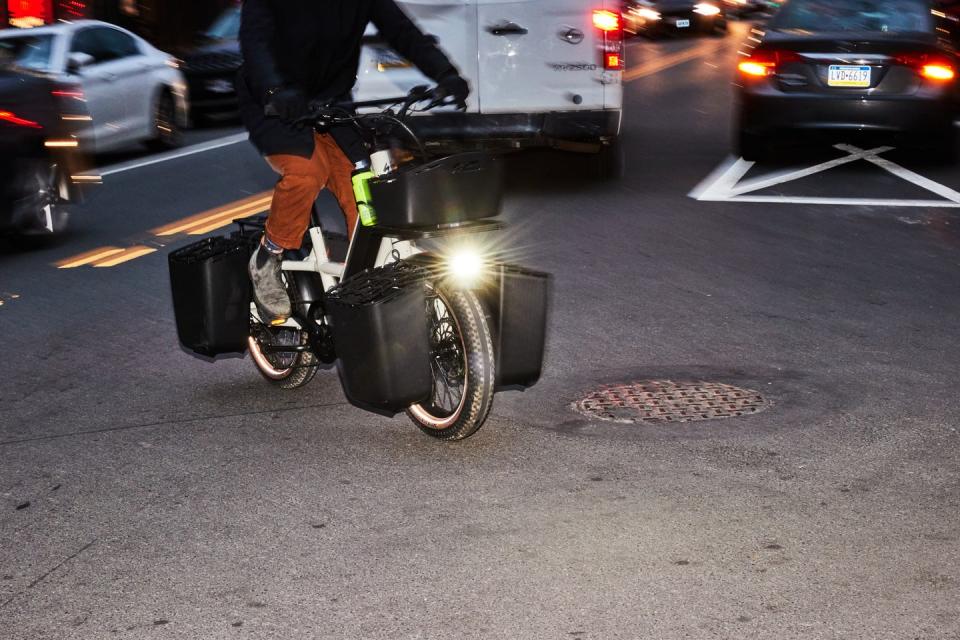
Lastly, because you are often on the road on an e-bike, and you are traveling at faster speeds, visibility is more important than ever. Visibility is both how you ride and how you set up your bike. “Hold your position on the road so cars can see you,” says Dewey, which means you want to sit upright so you’re taller. “Don’t weave in and out of parked cars. A lot of cyclists tend to think, ‘I want to be as far to the right as possible, so I’ll dodge into open parking spaces and then I’ll come back out.’ But that’s not a good idea. You want to be visible; you want people to see you on the road.”
As for literal visibility on the bike, many e-bikes come with front and rear lights, but if yours doesn’t, consider investing in a set. “Make sure your lights are illuminated if it’s dark, or if you’re riding at dusk or in inclement weather,” says Dewey. “And try to wear something with high-visibility on it.” Dewey is a fan of on-bike reflectors, as well as the reflectors that can clip onto the bottom of pants to create a safety cuff to protect pants from your chain, while also lighting you up.
You Might Also Like

